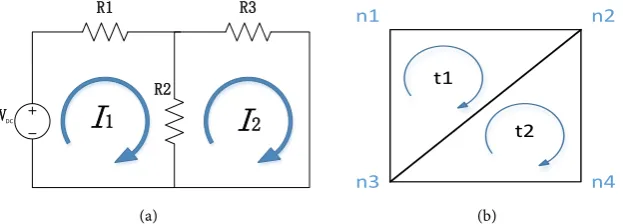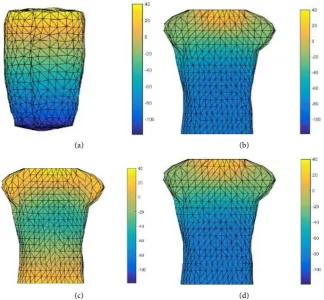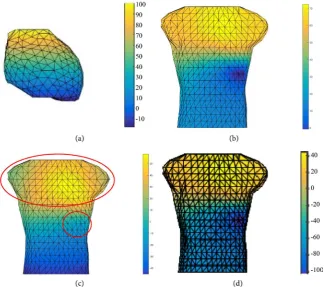ISSN Online: 2327-509X ISSN Print: 2327-5081
DOI: 10.4236/jbm.2018.61001 Dec. 29, 2017 1 Journal of Biosciences and Medicines
A Method for Normal Direction Judge Applied
in Electrocardiographic Problem
Chengcheng Tang, Jian Wu, Riqing Chen
Department of Biomedical Engineering, Tsinghua University, Beijing, China
Abstract
Boundary Element Method (BEM) is widely used in electrocardiographic (ECG) problem. Formulations of these problems based on mathematical and numerical approximations of the known source in heart and the volume con-ductor that can transfer voltages on the surface of the body. To analyze the electric potentials on body surface or epicardial surface, a set of discrete equa-tions derived from a boundary integral equaequa-tions need to be solved. Solving these equations means to get the potential distribution eventually. In the process of solving, transfer matrix of discrete equations has received consi-derable attention, how to get an appropriate transfer matrix is an important issue. This paper found that the direction of normal vector could affect the results when calculating the transfer matrix and presents a method analogous to Mesh Current Method to deal with this direction problem. Several simula-tions have been carried out to verify the accurate results with the correct di-rection of normal vector using new method within a torso model given si-multaneous epicardial and body surface potential recordings.
Keywords
ECG Problem, BEM, Transfer Matrix, Normal Vector, Direction
1. Introduction
Electrocardiographic problem, namely given the potential distribution at epicar-dial surface to calculate the distribution at body surface (Forward Problem), or vice versa (Inverse Problem), draws lots of attentions in biomedical area these years, as electrocardiography can be a powerful tool for diagnosis in clinic [1] [2] [3]. The potential distribution at epicardial surface and body surface are linked by a transfer matrix determined by the shape of heart and torso. Thus, both for-ward and inverse problem need to calculate the transfer matrix elements deter-How to cite this paper: Tang, C.C., Wu, J.
and Chen, R.Q. (2018) A Method for Nor-mal Direction Judge Applied in Electrocar-diographic Problem. Journal of Biosciences and Medicines, 6, 1-8.
https://doi.org/10.4236/jbm.2018.61001
DOI: 10.4236/jbm.2018.61001 2 Journal of Biosciences and Medicines mined by the geometry properties.
The boundary element method (BEM) is often an appropriate way to compute the transfer matrix, despite the different inner physical properties of the con-ductor medium when the medium is isotropic [4]. Barr et al. gives an overall theory of dealing with forward problem and inverse problem based on BEM [5]. Horácek et al. calculate transfer coefficients based on triangle-to-triangle discre-tization [6] [7], rather than node-to-node discrediscre-tization used by Barr et al. to construct appropriate matrices, these matrices are consisted of coefficients that relate to the potentials and their gradients on the epicardial surface of the con-ductor and the potential on the body surface [8] [9]. The corresponding boun-dary integral equation should be solved through discretizing the surface into triangle elements [10] [11]. Munck et al. uses analytically integrated elements to discretize the boundary integral equation linearly [12] [13].
The transfer matrix plays an important role in both forward problem and in-verse problem. In the calculation of the matrix, the direction of normal vector of the triangle segments should be paid attention to carefully. Some methods are designed to deal with this issue by the commercial programs. Take one method as an example, first, it finds a point that is definitely outside the mesh, and cal-culates the centers of the triangles. Then, it computes the distances between the centers of the triangles and the outer point which was found previously. After that, it finds the triangle closest to the point that is for sure outside the mesh based on the distances that have been calculated before. Next, the normal vector
n
of this triangle is computed out based on right hand’s rule according to index sequence of the three vertexes, and also the vector from the center of the nearest triangle to the outer point Pout. If P nout⋅ is negative, the order of the vertex index of each triangle would be adjusted to invertn
. However, this approach lets mistakes occur sometimes, it can’t make all the directions turn into right in some cases, which results in incorrect potential distribution eventually.Therefore, this paper presents a new method to figure out the correct triangle normal direction to get the accurate potential distribution on surface.
2. Basic Theory andMethod
2.1. Derivation of Transfer Matrix
First, deriving the integral equations. The potential φo at point O can be ex-pressed as Equation (1) using Green’s second law, and the point O is assumed as an observation point which inside the volume but very close to surface,
2 2
1 1 1
4 H 4 H 4 B
H
o S H H S H S B B
n
r ndS dS r ndS
r
r r
φ
φ
φ
φ
π
π
π
∇ ⋅
⋅ ⋅
= −
∫
−∫
+∫
. (1)DOI: 10.4236/jbm.2018.61001 3 Journal of Biosciences and Medicines of unit magnitude normal to surface element dS.
So, two equations can be obtained from Equation (1) for observation positions located on body and epicardial surface, respectively,
2 2
1 1 1 0
4 B 4 H 4 H
H B S Br nr dSB S H r nr dSH S r ndSH
φ
φ
φ
φ
π
π
π
∇ ⋅
⋅ ⋅
− +
∫
−∫
−∫
= , (2)2 2
1 1 1 0
4 B 4 H 4 H
H
B B H H H H
S S S
n
r ndS r ndS dS
r
r r
φ
φ
φ
φ
π
π
π
∇ ⋅
⋅ − − ⋅ − =
∫
∫
∫
. (3)To solve the Equation (2) and Equation (3) numerically, these equations should convert to simultaneous linear equations. Therefore, the surface S, con-sist of SB and SH , need to subdivide in small triangles, which means the inte-gration area will be partitioned into triangle elements. And Equations (2) and Equation (3) can be simplified by the element of solid angle i
ef
dΩ which is subtended at an observation point of the i-th location on surface e by an area element on surface f:
2 i
ef r n f
d dS
r
⋅
Ω = . (4)
As it can be seen here, if the direction of
n
is wrong, the sign ofr n
⋅
wouldn’t be correct, therefore, it will have influence on the solid angle, which means the result of potential distribution may not be right.Substituting Equation (4) in Equation (2) and Equation (3), and calculating the surface solid angle integration approximately by discretized triangle solid angle summation as the way shown in Equation (5). The coefficients of the components of gradients term are noted in Equation (6).
1 1 4 Y Y N Y XY XY Y S φ d P
π
∫
Ω =∑
Φ , (5)1 1 4 Y Y N Y
Y XY Y S r n dS G
φ π
∇ ⋅ =
∑
Γ∫
. (6)The different rows of matrices PXY and GXY corresponds to different loca-tions of the observer on surface X. As the theory showing, each of the P’s and G’s is a matrix of coefficients depending entirely on the geometry. In all cases the number of columns corresponds to the number of locations on the surface Y of integration [1]. Based on the derivation above, the equation about the potential distributions on epicardial surface and body surface can be derived as
B ZBH H
φ = φ , where ZBH is the transfer matrix described in Equation (7).
(
1) (
1 1)
BH BB BH HH HB BH HH HH BH
Z = P −G G P− − G G P− −P . (7)
2.2. Normal Direction Judge Methods
DOI: 10.4236/jbm.2018.61001 4 Journal of Biosciences and Medicines A new method is proposed to ensure the direction of
n
of each triangle ele-ment to be outward. The basic idea of this method comes from the application of Kirchhoff’s laws. There are two applications of Kirchhoff’s laws and Ohm’s law, the Branch Current method and the Mesh Current method. The Mesh Current method can solve a circuit with less variables and less equations by simply de-termine unknown currents of each mesh in a network. Like its name, mesh cur-rent, means a current that loops around the essential mesh. It encompasses all the component of the mesh. First, there are some loops need to be identified within the circuit. As can be seen in Figure 1(a), one loop formed by VDC, R1 and R2 while the other loop formed by R2, R3. These current meshes are connected with each other by loops. I1 and I2 is the current of each mesh re-spectively. The direction of each current is chosen arbitrarily, and the intersect-ing component will be “went through” by two currents based on the assumption of the method. Second, get all the voltage drops though each resistor according to the direction of mesh currents. Then use the Kirchhoff’s Voltage laws, get eq-uations state as 1 0n k k=V =
∑
. Solve a set of equations can get respective mesh current.In the theory of Mesh Current method, if all mesh currents are chosen in a same direction, either clockwise or counterclockwise, the direction of two mesh currents that go through the intersecting side of two meshes must be opposite. So, that kind of law can be used in determining the direction of
n
in turn. In other words, if applying the theory of Mesh Current method to determine the direction ofn
, some principles should be followed: the direction ofn
gives the direction of rotation according to the right-hand rule, the direction of rota-tion of each triangle element shows a direcrota-tion of each side of the triangle. If two triangles have contrary direction on their common side, it means the directions ofn
of them are at the same side. This can be seen in Figure 1(b).In that case, if the direction of
n
of a triangle could be determined, the di-rection ofn
of the neighborhood of this triangle also could be determined. Therefore, in this new method, it needs to figure out a reference normal vector (RNV) at first, then determine the others’ direction according to the direction of(a) (b)
Figure 1. (a) A circuit for Mesh Current method; (b) Geometry for two adjacent triangle elements. It contains two triangles with four nodes. Triangle t1 with n1, n2 and n3, tri-angle t2 with n2, n3 and n4. If the order of t1’s nodes is n1, n2, n3 and the order of t2’s nodes is n3, n2, n4, the direction of normal vector of these two triangles are the same.
DC V
R1 R3
R2
I
1I
2t1
t2
n1 n2
[image:4.595.217.529.553.665.2]DOI: 10.4236/jbm.2018.61001 5 Journal of Biosciences and Medicines the RNV. The triangle element of which
n
is ensured correct and is referred as reference triangle (RT). Check then
of triangle elements in the neighborhood, which share one of RT’s sides, and then check the neighborhood of these three triangles, and so on. Eventually, we can finish examination on all triangle ele-ments of the model.3. Simulation Results
The result of simulation can be carried out when using the one auto-solid angle approximation [3]. Data of epicardial surface potential distributions include a number of different sequences of cardiac excitation and repolarization, along with the geometric location (x, y, z coordinates) of each body and heart elec-trode. For the purpose of contrast, this paper introduces the result of node-to- node discretization as a reference distribution.
The simple model this paper chooses to simulate has 602 epicardial points and 771 body surface points, with a cylinder-shaped heart, which is shown in Figure 2(a) and Figure 2(c). The surface SB of this model is represented as 1538 tri-angle elements. The surface SH of this model is represented as 1200 triangle elements. The comparatively complex model we apply our method for has 337 epicardial points and 771 body surface points, with a relatively real-shaped heart, which is shown in Figure 2(b) and Figure 2(c). The surface SB of this model is represented as 1538 triangle elements. The surface SH of this model is represented as 976 triangle elements.
3.1. Simple Model
The simulation on simple model shows in Figure 3. Figure 3(a) gives the poten-tial distribution on epicardial surface which has been set as a known distribu-tion. Figure 3(b) shows the potential distribution on body surface, which is a reference result here. And the potential distribution on body surface calculated by a commercial program and the program with new method is shown in Figure 3(c) and Figure 3(d), respectively.
As it can be seen in Figure 3(a), the potential on heart surface is set to in-crease from the bottom to the top monotonously. Consequently, Figure 3(b) and Figure 3(d) show a reasonable monotonous potential distribution on the body surface. However, the bottom part of Figure 3(c) have significant differ-ences with Figure 3(b) and Figure 3(d), it shows an unreasonable reverse below the middle area, which means it is inaccurate.
3.2. Comparatively Complex Model
DOI: 10.4236/jbm.2018.61001 6 Journal of Biosciences and Medicines
(a) (b) (c)
Figure 2. (a) Simple heart model; (b) Comparatively complex heart model; and (c) Body model.
(a) (b)
(c) (d)
Figure 3. (a) Potential distribution on epicardial surface; (b) Reference potential distribu-tion on body surface; (c) Potential distribudistribu-tion on body surface calculated by a commer-cial program; (d) Potential distribution on body surface calculated by the method this paper presented.
potential distribution of body surface calculated by a commercial program and program of the new method are show in Figure 4(c) and Figure 4(d) respec-tively.
The results shown in Figure 4 are analogous to the results in Figure 3. The poten-tial on heart surface also increases from the bottom to the top monotonously. Figure 4(b) and Figure 4(d) still keep this property. But Figure 4(c) appears some abnor-mal distribution on the shoulder area, which exhibits its inaccuracy.
4. Conclusion
[image:6.595.252.513.72.159.2] [image:6.595.212.537.203.503.2]DOI: 10.4236/jbm.2018.61001 7 Journal of Biosciences and Medicines
Figure 4. (a) Potential distribution on epicardial surface; (b) Reference potential distribu-tion on body surface; (c) Potential distribudistribu-tion on body surface calculated by a commer-cial program; (d) Potential distribution on body surface calculated by the method this paper presented.
important for transfer matrix calculation in the electrocardiographic problem. It could be wrong sometimes if we do not deal with it appropriately. This paper presents a method analogous to mesh current method to judge the normal direc-tion of triangles. Principle and process of this method are analyzed and ex-plained in detail. The new method shows its accuracy in a simple and a more realistic heart shape model in the electrocardiographic problem. This method also has an inconvenient part, namely, an initial
n
of a triangle element needs to be determined first. Sometimes it should be checked manually if needed. What’s more, though the method does not require that either surface has any particular shape such as that of a sphere, it can’t work correctly when geometry is extremely complex. However, the new method this paper presented can deal with most situations with high accuracy.References
[1] Coll-Font, J., et al. (2014) New Additions to the Toolkit for Forward/Inverse Prob-lems in Electrocardiography within the SCIRun Problem Solving Environment.
Computing in Cardiology Conference, Cambridge, MA, 2014, 213-216.
[image:7.595.214.540.74.361.2]DOI: 10.4236/jbm.2018.61001 8 Journal of Biosciences and Medicines
[3] MacLeod, R. and Buist, M. (2010) The Forward Problem of Electrocardiography. In: Macfarlane, P.W., van Oosterom, A., Pahlm, O., Kligfield, P., Janse, M. and Camm, J., Eds., Comprehensive Electrocardiology, Springer Science & Business Media, 247-298.
[4] Bear, L., Dubois, R. and Zemzemi, N. (2016) Optimization of Organ Conductivity for the Forward Problem of Electrocardiography. Computing in Cardiology Confe-rence, IEEE, Vancouver, BC, 2016, 385-388.
[5] Barr, R.C. and Spach, M.S. (1977) Relating Epicardial to Body Surface Potential Distributions by Means of Transfer Coefficients Based on Geometry Measurements.
Biomedical Engineering, IEEE Transactions onBME, 24, 1-11. https://doi.org/10.1109/TBME.1977.326201
[6] Horáček, B.M. and Clements, J.C. (1997) The Inverse Problem of Electrocardiogra-phy: A Solution in Terms of Single- and Double-Layer Sources on the Epicardial Surface. Mathematical Biosciences, 144, 119-154.
https://doi.org/10.1016/S0025-5564(97)00024-2
[7] Van Oosterom, A. and Strackee, J. (1983) The Solid Angle of a Plane Triangle. IEEE Trans Biomed Eng., BME, 30, 125-126. https://doi.org/10.1109/TBME.1983.325207 [8] Tikhonov, A.N. and Arsenin, V.Y. (1977) Solutions of Ill-Posed Problems. V.H.
Winston & Sons, Washington DC.
[9] Hansen, P.C. and O’Leary, D.P. (1993) The Use of the l-Curve in the Regularization of Discrete Ill-Posed Problems. Siam Journal on Scientific Computing, 14, 1487-1503. https://doi.org/10.1137/0914086
[10] Assecondi, S., Hallez, H., D’Asseler, Y. and Lemahieu, I. (2007) Comparison of Dif-ferent Auto-Solid Angle Approximations in BEM for EEG Dipole Source Localiza-tion. Joint Meeting of the International Symposium on Noninvasive Functional Source Imaging of the Brain and Heart and the International Conference on Func-tional Biomedical Imaging, Nfsi-Icfbi IEEE, 2007, 70-73.
[11] Yao, B., Pei, S. and Yang, H. (2016) Mesh Resolution Impacts the accuracy of In-verse and Forward ECG Problems. 38th Annual International Conference of the IEEE Engineering in Medicine and Biology Society (EMBC), Orlando, FL, 4047-4050.
[12] de Munck, J.C. (1992) A Linear Discretization of the Volume Conductor Boundary Integral Equation Using Analytically Integrated Elements. IEEE Transactions on Biomedical Engineering, 39, 986-990. https://doi.org/10.1109/10.256433


